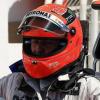Walls closer to the track, an alternative for run offs and chicanes
#1

Posted 04 June 2008 - 14:35
http://www.autosport...rt.php/id/67966
Couldn't that be an alternative to the current trend of having one mile run offs and chicanes that kill the character of all tracks? A couple of years ago I had the same sort of idea after watching some high speed Indycar crashes on US ovals. On an oval there is no room for runoff and the wall is directly near the track. In case of a crash most cars hit the wall sideways and hence in a relatively better angle of impact. From that point of view I doubt whether Ayrton Senna's crash would had been fatal with the wall directly near the track.
What's your view on it?
Advertisement
#2

Posted 04 June 2008 - 14:37
#3

Posted 04 June 2008 - 14:39
Originally posted by Pingguest
The Canadian Grand Prix officials have done some modifications to the Circuit de Gilles Villeneuve, including moving the wall at Kubica's crash site closer to the track.
http://www.autosport...rt.php/id/67966
Couldn't that be an alternative to the current trend of having one mile run offs and chicanes that kill the character of all tracks? A couple of years ago I had the same sort of idea after watching some high speed Indycar crashes on US ovals. On an oval there is no room for runoff and the wall is directly near the track. In case of a crash most cars hit the wall sideways and hence in a relatively better angle of impact. From that point of view I doubt whether Ayrton Senna's crash would had been fatal with the wall directly near the track.
What's your view on it?
Senna would have simply hit the wall at a higher speed and the same angle.
I'm not sure how the Canada modifications would have changed the angle of Kubica's crash.
#4

Posted 04 June 2008 - 14:46
#5

Posted 04 June 2008 - 15:27
Originally posted by Ross Stonefeld
I'm not sure how the Canada modifications would have changed the angle of Kubica's crash.
Didn't the angle of the Kubica wall mean he hit it square on? The modifications mean the angle will be less.
#6

Posted 04 June 2008 - 15:44
He hit the main wall square on, but that was because he clipped another bit of wall by a marshal's access point with his front right wheel first which changed the direction the car was pointing. I imagine they've changed the location of this gap in the wall as well as the angle of the wall itself.Originally posted by potmotr
Didn't the angle of the Kubica wall mean he hit it square on? The modifications mean the angle will be less.
#7

Posted 04 June 2008 - 16:16
#8

Posted 04 June 2008 - 16:41
Tamburello was too sharp to make this a viable solution, although IMO it would have been far better to make the corner a little faster and straighter and moved the wall closer to the track, than implement the chicane they did, which helped effect the total destruction of the circuit's flow in 1995. And obviously putting the barriers closer to the track at somewhere like the Old Pits hairpin would be mental.
#9

Posted 04 June 2008 - 16:57
Originally posted by D A
For the NASCAR Busch race last year (in August) they had added a piece of concrete wall contected the two pieces already in place (looked pretty much like a patch job). That modification made the wall's angle quite close to that of the actual track. To hit it at any kind of angle you'd already have have been going quite a bit sideways.
It was indeed a patch job for the NASCAR race, but it was the right thing to do considering what had happened there with Kubica.
You can see the 2008 modifications here
Similar changes were also made to the corner where Panis crashed in 1997. The tyres were removed and rails were added in right on the outside of the corner. So if a car loses it there, they'll be slamming rigth into the rails. These changes were made following a Star Mazda race in 2006 where a car was lauched in the air after ramming the tyre wall.
#10

Posted 04 June 2008 - 20:11
Originally posted by Ross Stonefeld
Senna would have simply hit the wall at a higher speed and the same angle.
I'm not sure how the Canada modifications would have changed the angle of Kubica's crash.
That's not true, the further the wall the more head on you hit.
I think a wide runoff is good if it's far enought for the cars even missing a couple of wheels can have a big speed reduction over it. If not the wall by the track is better in this sense.
But the close wall has the bad habit of reflectiong the cars back to the track, and then we have a pile up.
#11

Posted 04 June 2008 - 20:17
The problem in Senna´s crash was lack of runoff. The barrier/wall was ridiculously close considering the speed they were doing around that particular curve.
#12

Posted 04 June 2008 - 20:28
Originally posted by cheesy poofs
You can see the 2008 modifications here
modification looks good to me ... just long enough to prevent finding that kinked piece of wall with the same nasty head-on angle that nearly did for robert, but still enough room left elsewhere.
plenty of other parts of the canada circuit are also up-close to the walls, so i can't see it being too much of a problem.
#13

Posted 05 June 2008 - 04:04
#14

Posted 05 June 2008 - 04:05
Originally posted by ex Rhodie racer
The problem in Senna´s crash was lack of runoff. The barrier/wall was ridiculously close considering the speed they were doing around that particular curve.
Senna's problem was a suspension arm piercing his helmet.
#15

Posted 05 June 2008 - 07:24
Something that probably wouldn´t have happened if the wall hadn´t been there. Or do you think the suspension arm flew off before he made contact?Originally posted by Mat
Senna's problem was a suspension arm piercing his helmet.
#16

Posted 05 June 2008 - 07:25
He also had a neck/skull fracture, iirc.
#17

Posted 05 June 2008 - 07:29
#18

Posted 05 June 2008 - 07:57
how mobile are the safer barriers? i presume u could take them out easily enough if needed... for bikes u could put in soft foam blocks, airbags or similer in place or infront of the safer barrier
#19

Posted 05 June 2008 - 08:16
Originally posted by Ross Stonefeld
So he should have crashed into the river instead?
Ross, that was a silly statement and not one I would have expected from you. Of course he shouldn´t have crashed into the river instead, but because it was impossible to extend the runoff due to the river being there in the first place, a curve such as the one that existed should never have been constructed at that point.
Senna wasn´t the only one to die at that particular spot. Pat Evans was killed there in 1976, and there were others I believe.
Solid objects, when hit, either by competitors on 2 wheels or 4, are the primary cause of fatal accidents. The only way to prevent contact is to move the solid stuff as far from the sides of the road as possible. And if (as in Imola´s case at the spot where Senna crashed) it´s not possible, then alterations should be made to the track (as has now been done) so that the danger is eliminated, or at the very least, considerably reduced. Having said that, I don´t believe chicanes are the answer, but there are other alternatives. Chicanes are just cheaper.
It´s really not rocket science you know.
Advertisement
#20

Posted 05 June 2008 - 10:42
Originally posted by ex Rhodie racer
Something that probably wouldn´t have happened if the wall hadn´t been there. Or do you think the suspension arm flew off before he made contact?
You could re-create Senna's accident over and over to the minute detail and i bet you would struggle to have the suspension pierce the helmet again.
#21

Posted 05 June 2008 - 10:44
#22

Posted 05 June 2008 - 11:15
Not true. What it showed us is that there must be an effective way to slow the car down before impact if the barriers are close relative to the speed. Of course the angle of impact will have an effect, but speed on impact is far more serious.Originally posted by bogi
It's all about angle of attack, Kova showed us that run off area means nothing when you hit at 90°.
#23

Posted 05 June 2008 - 12:03
Originally posted by ex Rhodie racer
Not true. What it showed us is that there must be an effective way to slow the car down before impact if the barriers are close relative to the speed. Of course the angle of impact will have an effect, but speed on impact is far more serious.
Wha helped it getting really ugly was the car getting airborne as soon as it left the track. That was a big mistake in the kerb/runoff design.
#24

Posted 05 June 2008 - 12:13
Yes, you are correct. That certainly played a role.Originally posted by saudoso
Wha helped it getting really ugly was the car getting airborne as soon as it left the track. That was a big mistake in the kerb/runoff design.
#25

Posted 05 June 2008 - 12:18
i think this is the same thingOriginally posted by ex Rhodie racer
Of course the angle of impact will have an effect, but speed on impact is far more serious.
don't look at it as speed on the speedometer (relative to the asphalt) but as speed relative to the wall...this takes into account the angle
#26

Posted 05 June 2008 - 12:31
Of course, with all the cars being north poled then it could cause a problem with overtaking, the expression "wheel to wheel" might be all too true.
Regards
Bored at work ( obviously!
#27

Posted 05 June 2008 - 12:38
Closer walls?!?!?
You have got to be kidding me! The reason I hate street circuits is that they're nothing more than tunnels lined by walls. There is zero character of whatever city they're racing in left (Monaco being the sole exception). Too ****ing ugly to be called racing.
Oh and everytime there's the smallest of accidents everything has to be either full course caution or red flagged because the track is now covered in debris which has all been nicely contained within the walls.
Dumbest idea since voting for Max.
Neil
#28

Posted 05 June 2008 - 13:29
#29

Posted 05 June 2008 - 13:32
Originally posted by Option1
More walls?!?!?

Closer walls?!?!?

You have got to be kidding me! The reason I hate street circuits is that they're nothing more than tunnels lined by walls. There is zero character of whatever city they're racing in left (Monaco being the sole exception). Too ****ing ugly to be called racing.
Oh and everytime there's the smallest of accidents everything has to be either full course caution or red flagged because the track is now covered in debris which has all been nicely contained within the walls.
Dumbest idea since voting for Max.


Neil
stop whingin,if its that big a deal to ya,either stop watchin motor racin or come up with ur own ideas,send em to the FIA n see wot they say-can guarantee urs wudnt be as good as theirs-sayin every little accident even the smallest 1s need a safety car,red flag etc,rubbish,look at kimi n sutil,that didnt require a safety car now did it?whingin sod
#30

Posted 05 June 2008 - 13:51
Neil
#31

Posted 05 June 2008 - 13:54
Agreed. I was responding to those who wanted to go the whole hog.Originally posted by wingwalker
You guys are reading too much in this. One wall was moved closer to the track, cause in that particular case, it makes it safer. It's not like FIA has changed safety policy. Duh.
Neil
#32

Posted 05 June 2008 - 14:40
He hasn´t attended much school either by the looks of things.Originally posted by Option1
You haven't watched much racing on street circuits have you stevvvy boy?
Neil
#33

Posted 05 June 2008 - 15:01
#34

Posted 05 June 2008 - 15:28
#35

Posted 05 June 2008 - 15:30
That wasn´t an insult, it was a joke, hence the smiley.Originally posted by stevvy1986
n yes i have been to school thanks,mayb ya can come up with a better attempt of an insult than that next time?
#36

Posted 05 June 2008 - 15:42
Good point.Originally posted by Mat
im surprised they didnt install a SAFER barrier there. It seemed like a good position and opportunity to try it at an F1 track.
#37

Posted 05 June 2008 - 18:44
That's not true, that's not how geometry of it works. The farther away the wall is from the point where you lose control of the car, the sharper the angle of the eventual impact will be.Originally posted by Ross Stonefeld
Senna would have simply hit the wall at a higher speed and the same angle.
I'm not sure how the Canada modifications would have changed the angle of Kubica's crash.
The highly non-technical explanation is that the farther away from the wall you are, the more length of the corner you cover before you hit the wall, giving the wall "more time" to curve back at you.
The technical proof of it is fairly obvious if you draw a diagram with two versions of the wall, and measure how a car going straight on is going to impact them, and at what angles (the angle is the angle of the car's trajectory and the line tangent to the wall at the point of impact). You won't even have to do the math to see that the angles are going to be different, it will be fairly apparent to the naked eye, but doing the math will confirm what your eye will be telling you.
#38

Posted 05 June 2008 - 19:13
#39

Posted 06 June 2008 - 06:00
Newton tells us a body will try to keep moving in the same direction unless acted on by another force.A fully oversteering car,although out of driver control,IS STILL TRYING TO GO STRAIGHT AHEAD,it just wants to rotate while its doing it which slows it down very quickly on tarmac..An understeering car is more of a problem it's looking for something to hit right away,and it is preferable to be at a very shallow angle.A hunk of rubber or foam in front of a solid barrier is not going to make any difference at 150+ kmh head on.


























